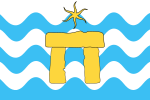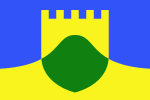 |
2000—Present |
Attard (village) |
A blue cross that represents Roman Catholicism and St. Mary with a red square in the middle on white background.
|
 |
1993—Present |
Balzan (village) |
A red horizontal line between two some horizontal green lines, on white background.
|
 |
1993—Present |
Birgu – Città Vittoriosa (city) |
Sword held upright and laurel are symbolizing the winner, olive probably the peace afterwards. A number of variants of the flag are known to exist.
|
 |
1993—Present |
Birkirkara (town) |
Horizontally divided red over white, the top (red) stripe about half as wide as the bottom (white) one. A St. Edward's crown centred on the red stripe, a red Greek cross centred on the white stripe.
|
 |
1993—2000 |
Birżebbuġa (village) |
Dark blue with a yellow chain in orle and two yellow crossed keys in the centre.
|
 |
2000—Present |
Birżebbuġa (village) |
An olive plant representing this locality, and the colour blue because it is near the sea.
|
 |
1993—Present |
Bormla – Città Cospicua (city) |
A cotton plant on a yellow background.
|
 |
1993—Present |
Dingli (village) |
Segmented diagonally in four triangles: two light blue facing each other horizontally and two red ones facing each other vertically, all separated with a white band.
|
 |
1993—Present |
Fgura (town) |
A white flag with a red horizontal line, and three gold stars on the line. Similar to the flag of Kerċem.
|
 |
1993—2006 |
Floriana (town) |
Divided per pale. The dexter side shows a red rampant lion with a golden head in a white field. The sinister side shows a golden winged arm holding upright a sword in natural colour. It was based on the coat of arms of Grandmaster António Manoel de Vilhena. A variant of this flag also existed.
|
 |
2006—Present |
Floriana (town) |
Red rampant lion on a white background, taken from the coat of arms of Grandmaster António Manoel de Vilhena.
|
 |
1993—Present |
Gudja (village) |
White flag with a red pointed bar.
|
 |
1993—Present |
Gżira (town) |
A blue flag with a white wavy stripe from the top hoist to the bottom fly; on the top fly, a yellow heraldic ship, on the bottom hoist a yellow heraldic dolphin with a red tongue.
|
 |
1993—Present |
Għargħur (village) |
A white flag with a red triangle from the bottom and a red star on top.
|
 |
1993—Present |
Għaxaq (village) |
White flag defaced by three green bars.
|
 |
1993—Present |
Ħamrun (town) |
Red flag with a white border. A variant flag is known to exist.
|
 |
1993—Present |
Iklin (village) |
Blue flag with Saint Michael holding a flaming sword and a shield with a green cross. Similar to the Flag of Kyiv.
|
 |
1993—Present |
Isla – Città Invicta (city) |
A yellow flag with a black saltire, on its ends and centre five white pilgrim's scallops.
|
 |
1993—2009 |
Kalkara (village) |
A yellow and blue flag with a flame on the blue field.
|
|
2009—Present |
Kalkara (village) |
Yellow and blue flag with a flame erupting from the line joining the two fields, with a green border.
|
 |
1993—Present |
Kirkop (village) |
White flag with a red band in the centre, connected to the bottom with another red band forming a shape similar to that of a T.
|
 |
1993—2000 |
Lija (village) |
An orange tree rising from a green mound on a white field.
|
 |
2000—Present |
Lija (village) |
Orange branch with three oranges, with a red square on the left and a red one on the right.
Current flag adopted in 2000.
|
 |
1993—Present |
Luqa (village) |
White flag with a red saltire. Similar to the Saint Patrick's Saltire and the flag of Marsaxlokk.
|
 |
1993—Present |
Marsa (town) |
A sailing ship on a red and white or blue and white background.
|
 |
1993—Present |
Marsaskala (village) |
Green flag divided by a downward pointing wedge shaped like an equilateral or at least nearly equilateral triangle. The wedge is white with three blue wavy fessy lines.
|
 |
1993—Present |
Marsaxlokk (village) |
White flag with a blue saltire. A variant flag is known to exist. Similar the flag of Luqa.
|
 |
1993—2000 |
Mellieħa (village) |
A blue field with a sinister bendy white line and a white 5-point star upon the sinister chief point.
|
 |
2000—Present |
Mellieħa (village) |
Blue flag with a white six-pointed star and a golden chevron.
|
 |
1993—Present |
Mdina (city) |
Undefaced white-red vertical bicolor. This was the unofficial flag of Malta until 1943. A variant flag is known to exist.
|
 |
1993—2000 |
Mġarr (village) |
A blue field with a yellow cartwheel.
|
 |
2000—Present |
Mġarr (village) |
A trilithon, symbol of Skorba Temples, on wavy blue and white lines.
|
 |
1993—c.2007 |
Mosta (town) |
A white flag with a red cross. In the centre of the cross is a blue star within a gold circle.
|
 |
c.2007—Present |
Mosta (town) |
A white flag representing the actual town of Mosta with a red cross representing the Catholic faith among the people of Mosta. The yellow circle in the middle represents the Rotunda, which is one of the most recognised landmarks in Malta, within the circle is a white star on a blue background representing St.Mary, who is the patron saint of Mosta.
Current flag adopted 2006 or 2007.
|
 |
1993—Present |
Mqabba (village) |
Red flag with a white stripe from upper hoist to lower fly.
|
 |
1993—Present |
Msida (town) |
Green flag with two white stripes from upper hoist to lower fly.
|
 |
2000—Present |
Mtarfa (village) |
Flag possibly representing the Mtarfa barracks.
|
 |
1993—c.2000 |
Naxxar (town) |
White-red horizontal bicolour, with a counterchanged cross in the middle.
|
 |
c.2000—Present |
Naxxar (town) |
White-red vertical bicolour, with a counterchanged cross in the middle. Similar to the flags of Sliema and Żurrieq.
|
 |
1994—1996 |
Paola (village) |
A golden spiral on a red background.
|
|
1996—Present |
Paola (village) |
Three spirals on the top part representing the Hal Saflieni Hypogeum. The three peacocks in the lower part are derived from the arms of the original founder of the town Grand Master Antoine de Paule.
|
 |
1993—Present |
Pembroke (village) |
Fourteen castles representing the coastal watchtowers erected by Grand Master Martin De Redin. The swords represent the fact that Pembroke was built on former British barracks.
|
 |
1993—Present |
Pietà (village) |
A pelican sitting in a nest with several ducklings, feeding them by letting some blood from her chest, thus vulning herself.
|
 |
1993—Present |
Qormi – Città Pinto (city) |
A white flag with the five crescents of Manuel Pinto de Fonseca.
|
 |
1993—2000 |
Qrendi (village) |
White star on a blue flag.
|
 |
2000—Present |
Qrendi (village) |
White star on a blue flag with a yellow border.
|
 |
1993—Present |
Rabat (town) |
Flag of Mdina defaced by an olive branch.
|
 |
1993—Present |
Safi (village) |
White flag defaced by a single blue bar.
|
 |
1993—Present |
San Ġiljan – Portus Sancti Juliani (village) |
White flag with three vertical red bars.
|
 |
1993—Present |
San Ġwann (town) |
The paschal lamb, a usual attribute of St John the Baptist on a red background.
|
 |
1993—Present |
San Pawl il-Baħar (town) |
The wavy lines are symbolizing the bay. Snake and sword are the attributes of St. Paul, who is said to be shipwrecked on a small island in the bay. The sword is cross-shaped and therefore represents the new religion. The snake refers to the story told in Acts 28, v. 3–6, where St. Paul is attacked by a snake but is not injured. He throws the snake into the fire and the locals from that moment believe that he is a God.
|
 |
1993—Present |
Santa Luċija (village) |
Sun on a black background.
|
 |
1993—Present |
Santa Venera (village) |
Red flag with a white bar, and three red fleur de lys on the bar. The fleur de lys come from the arms of Grandmaster Alof de Wignacourt.
|
 |
1993—2001 |
Siġġiewi – Città Ferdinand (city) |
A white background with a single red bar in the middle and a gold cross on the bar.
|
 |
2001—Present |
Siġġiewi – Città Ferdinand (city) |
A white background with 2 red stripes and a golden cross depicting the villagers' faith in Christianity. A flag half yellow and half red represents this village.
Current flag was adopted in April 2001.
|
 |
1993—Present |
Sliema (town) |
Traditional flag of Malta with a counterchanged Stella Maris. Similar to the flag of Naxxar.
|
 |
1993—Present |
Swieqi (village) |
Saltire representing the suburb of Saint Andrew's, top and bottom quarters represent the suburb of Ibraġ, and others represent the main village of Swieqi.
|
 |
1993—Present |
Tarxien (village) |
White flag divided by two blue vertical stripes.
|
 |
1993—Present |
Ta' Xbiex (village) |
A yellow ship's wheel on a green background.
|
 |
1993—Present |
Il-Belt Valletta – Città Umilissima (capital city) |
A red flag with a yellow lion rampant, taken from the arms of Grandmaster de Vallette.
|
 |
1993—2000 |
Xgħajra (village) |
Three ears of wheat on a blue background.
|
 |
2000—Present |
Xgħajra (village) |
The flag represents the beginning of the town, because the town started after the British government built a battery in what is now Xgħajra. The people working there started living round this battery and thus a small hamlet was formed, which eventually evolved into a small town. A variant flag is known to exist.
|
 |
1993—Present |
Żabbar – Città Hompesch (city) |
Red flag with a white saltire.
|
 |
1993—2000 |
Żebbuġ – Città Rohan (city) |
Nine red diamonds outlined in gold (arranged in three lines of three) on a red field.
|
 |
2000—Present |
Żebbuġ – Città Rohan (city) |
A canting olive branch above the arms of Grand Master de Rohan (nine red diamonds outlined in gold on a red field). A variant flag is known to exist.
|
 |
1993—Present |
Żejtun – Città Beland (city) |
White rectangular flag quartered by a green cross.
|
 |
1993—Present |
Żurrieq (village) |
White-blue horizontal bicolour, with a counterchanged cross in the middle. Similar to the flag of Naxxar.
|


















































































































